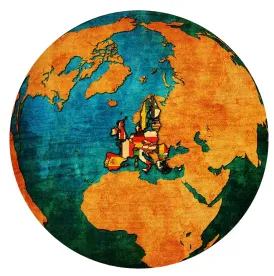On July 14, 2021, the European Commission adopted a package of proposals including a proposal for a Carbon Border Adjustment Mechanism (CBAM). The CBAM proposal is a key element of the European Green Deal (Green Deal), which sets an ambitious goal for the European Union (EU) to reduce greenhouse gas emissions by at least 55% by 2030 compared to 1990 levels, and to make Europe a climate-neutral continent by 2050.
Businesses in Russia, Turkey, China, and the United Kingdom are expected to be impacted the most by the new legislation, since they are the largest suppliers of products covered by the CBAM to the EU.
The Proposed Regulation Establishing a Carbon Border Adjustment Mechanism
The ambitions from the Green Deal result in high CO2 costs due to higher tax rates for companies producing in the EU. Because these costs are not incurred or are only incurred to a lesser extent by companies in other regions, the disparity can lead to so-called carbon leakage where companies in the EU shift their activities to regions that impose lower or no costs on a company’s carbon emissions. In that case, the “waterbed effect” would prevent the global emissions from decreasing.
To prevent this, the new CBAM will put a carbon price on imports of a targeted selection of products. This reduces the economic incentive to shift production to countries that impose a lower cost on carbon emissions and creates greater certainty that European carbon regulation will contribute to an actual decline in global carbon emissions. The CBAM also aims to encourage industry outside the EU to take steps in the same direction.
Under the CBAM, companies importing into the EU (EU importers) will buy carbon certificates corresponding to the carbon price that would have been paid on certain goods had the goods been produced under the EU’s carbon pricing rules. Conversely, once a non-EU producer can show that it has already paid a price for the carbon used in the production of the imported goods in a third country, the corresponding cost can be fully deducted for the EU importer.
The CBAM will be phased in gradually and will initially only apply to a selected number of goods with a high risk of carbon leakage, such as iron, steel, cement, fertilizer, aluminum and electricity generation. As from 1 January 2023, EU importers will have to report emissions embedded for those types of products.
In addition, EU importers will start paying a financial adjustment from 1 January 2026. EU importers will then have to declare annually, by 31 May, the quantity of goods and the amount of embedded emissions in the total goods they imported into the EU in the preceding year and hand over the corresponding amount of CBAM certificates.
The Carbon Border Adjustment Mechanism and Emissions Trading System
The Emissions Trading System (ETS) sets a cap on the amount of greenhouse gas emissions that can be released from industrial installations in certain sectors. Companies must purchase allowances on the ETS trading market, though a certain number of free allowances is distributed to prevent carbon leakage. The CBAM will progressively become an alternative to the ETS. Furthermore, for the CBAM sectors, the free allowances that have been freely allocated to prevent leakage (i.e., eliminate the economic benefit of dispatching activities to markets with less regulation of carbon emissions) will gradually be phased out beginning 2026.
To complement the ETS, the CBAM will be based on a system of certificates to cover the embedded emissions in products being subsequently imported into the EU. The CBAM is not a ‘cap and trade’ system, meaning it does not set a limit on pollution. Instead, the CBAM certificates mirror the ETS price and, by subjecting imported products to the same carbon costs as domestically produced products, is intended to reduce or eliminate the economic incentives that lead to leakage.
The Carbon Border Adjustment Mechanism in practice
The price of the certificates will be calculated depending on the weekly average auction price of EU ETS allowances expressed in EUR / ton of CO2 emitted. EU importers of the goods will have to, either individually or through a representative, register with national authorities where they can also buy CBAM certificates.
National authorities will authorize registration of declarants in the CBAM system, as well as reviewing and verifying declarations.
The compliance under the CBAM is technical and therefore expected to have substantive administrative impact.
Scope
In principle, imports of goods from all non-EU countries will be covered by the CBAM. As stated above, initially it will apply only to a selected number of goods at high risk of carbon leakage. Certain third countries who participate in the ETS or have an emissions trading system linked to the EU’s already incur carbon costs similar to domestic companies and, as a result, will be excluded from the mechanism. This is the case for members of the European Economic Area and Switzerland.
The CBAM should initially apply to direct emissions (i.e., emissions taking place as part of the production process of goods of which the producer has direct control) from the production of goods up to the time of import into the customs territory of the EU, and after the end of a transition period and upon further assessment, as well to indirect emissions (i.e., emissions from the production of electricity, heating, and cooling, which is consumed during the production processes of goods), mirroring the scope of the EU ETS.
Finally, goods can only be imported into the customs territory of the EU by a declarant that is authorized by the competent authority.
Conclusion
As stated above, this concerns a proposal. The CBAM is therefore still subject to discussion and review within the EU, and the final version may differ slightly.
Companies importing any of the goods in scope of the CBAM should understand the potential impact of the costs of the CBAM on their business process. It is furthermore essential to make sure the correct formalities are considered to ensure compliance with the CBAM and subsequently avoid potential penalties.
If the proposal is adopted without change, EU importers will have to report emissions embedded in iron, steel, cement, fertilizer, aluminum, and electricity generation as from 1 January 2023. In addition, EU importers will start paying a financial adjustment from 1 January 2026.





 />i
/>i

